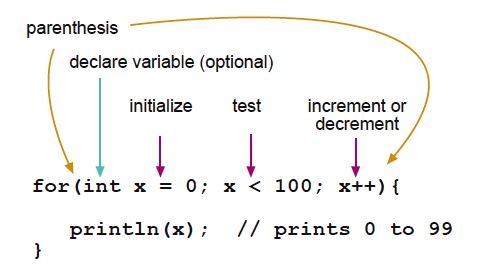Reference Language | Libraries | Comparison | Changes
for statements
Desciption
The for statement is used to repeat a block of statements enclosed in curly braces. An increment counter is usually used to increment and terminate the loop. The for statement is useful for any repetitive operation, and is often used in combination with arrays to operate on collections of data/pins.
There are three parts to the for loop header:
for (initialization; condition; increment) {
//statement(s);
}

The initialization happens first and exactly once. Each time through the loop, the condition is tested; if it's true, the statement block, and the increment is executed, then the condition is tested again. When the condition becomes false, the loop ends.
Example
// Dim an LED using a PWM pin
int PWMpin = 10; // LED in series with 470 ohm resistor on pin 10
void setup()
{
// no setup needed
}
void loop()
{
for (int i=0; i <= 255; i++){
analogWrite(PWMpin, i);
delay(10);
}
}
Coding Tips
The C for loop is much more flexible than for loops found in some other computer languages, including BASIC. Any or all of the three header elements may be omitted, although the semicolons are required. Also the statements for initialization, condition, and increment can be any valid C statements with unrelated variables, and use any C datatypes including floats. These types of unusual for statements may provide solutions to some rare programming problems.
For example, using a multiplication in the increment line will generate a logarithmic progression:
for(int x = 2; x < 100; x = x * 1.5){
println(x);
}
Generates: 2,3,4,6,9,13,19,28,42,63,94
Another example, fade an LED up and down with one for loop:
void loop()
{
int x = 1;
for (int i = 0; i > -1; i = i + x){
analogWrite(PWMpin, i);
if (i = 255) x = -1; // switch direction at peak
delay(10);
}
}
See also
Corrections, suggestions, and new documentation should be posted to the Forum.
This reference is licensed under a Creative Commons Attribution-ShareAlike 3.0 License and is based on the Arduino reference. Code samples in the reference are released into the public domain.